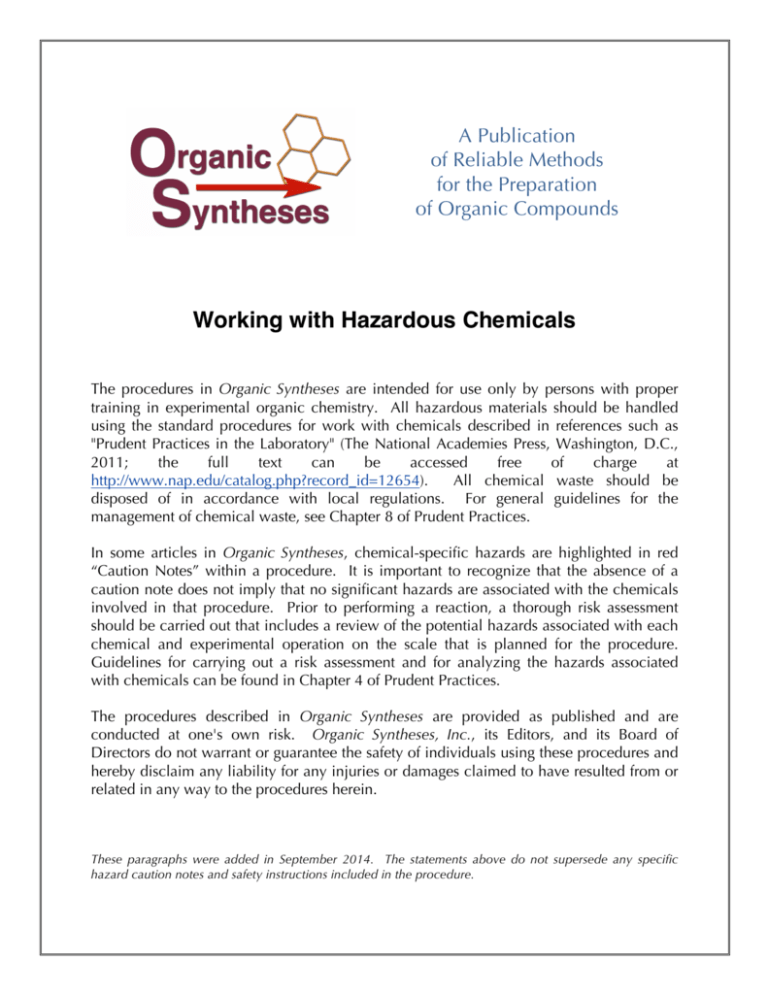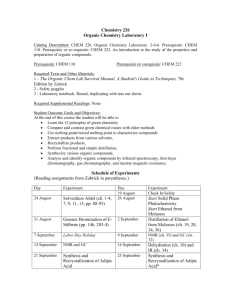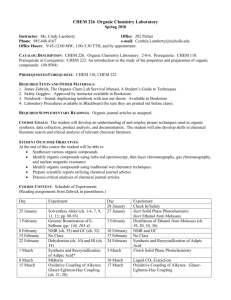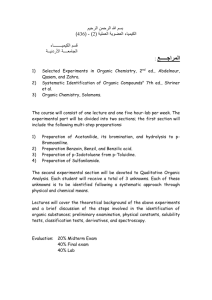
A Publication
of Reliable Methods
for the Preparation
of Organic Compounds
Working with Hazardous Chemicals
The procedures in Organic Syntheses are intended for use only by persons with proper
training in experimental organic chemistry. All hazardous materials should be handled
using the standard procedures for work with chemicals described in references such as
"Prudent Practices in the Laboratory" (The National Academies Press, Washington, D.C.,
2011;
the
full
text
can
be
accessed
free
of
charge
at
http://www.nap.edu/catalog.php?record_id=12654).
All chemical waste should be
disposed of in accordance with local regulations. For general guidelines for the
management of chemical waste, see Chapter 8 of Prudent Practices.
In some articles in Organic Syntheses, chemical-specific hazards are highlighted in red
“Caution Notes” within a procedure. It is important to recognize that the absence of a
caution note does not imply that no significant hazards are associated with the chemicals
involved in that procedure. Prior to performing a reaction, a thorough risk assessment
should be carried out that includes a review of the potential hazards associated with each
chemical and experimental operation on the scale that is planned for the procedure.
Guidelines for carrying out a risk assessment and for analyzing the hazards associated
with chemicals can be found in Chapter 4 of Prudent Practices.
The procedures described in Organic Syntheses are provided as published and are
conducted at one's own risk. Organic Syntheses, Inc., its Editors, and its Board of
Directors do not warrant or guarantee the safety of individuals using these procedures and
hereby disclaim any liability for any injuries or damages claimed to have resulted from or
related in any way to the procedures herein.
These paragraphs were added in September 2014. The statements above do not supersede any specific
hazard caution notes and safety instructions included in the procedure.
DOI:10.15227/orgsyn.057.0083
Organic Syntheses, Coll. Vol. 6, p.893 (1988); Vol. 57, p.83 (1977).
3-PHENYL-2H-AZIRINE-2-CARBOXALDEHYDE
[2H-Azirine-2-carboxaldehyde, 3-phenyl-]
Submitted by Albert Padwa1, Thomas Blacklock, and Alan Tremper.
Checked by W. F. Oettle, E. R. Holler, and William A. Sheppard.
1. Procedure
Caution! Although the organic azide intermediates used in this procedure have not shown any
explosive hazard under the experimental conditions, they should always be handled with adequate
shielding and normal protective equipment such as face shield and leather gloves.
A. (1-Azido-2-iodo-3,3-dimethoxypropyl)benzene. A dry, 1-l., three-necked, round-bottomed flask
fitted with an efficient magnetic stirrer and two 250-ml. pressure-equalizing dropping funnels charged
with 75 g. (1.l moles) of sodium azide and 450 ml. of dry acetonitrile (Note 1). The mixture is stirred
and cooled in an ice–salt bath (−5° to 0°), and 83 g. (0.51 mole) of iodine monochloride (Note 2) is
added dropwise from one of the addition funnels over 10–20 minutes. The solution is stirred for an
additional 5–10 minutes before 81 g. (0.45 mole) of cinnamaldehyde dimethyl acetal (Note 3) is added
from the other dropping funnel over a 15–20 minute period, while the cooling bath temperature is
maintained at 0–5°. The resulting red-brown mixture is stirred for 12 hours at room temperature, poured
into 500 ml. of water, and extracted with three 500-ml. portions of diethyl ether. The combined organic
extracts are washed successively with 700 ml. of 5% aqueous sodium thiosulfate (Note 4) and 1 l. of
water. The ether solution in dried over magnesium sulfate. The solvent is removed with a rotary
evaporator, giving the azide product as a orange oil (Note 5), 150–156 g. (97–98%), of sufficient purity
to be used for the next step.
B. (1-Azido-3,3-dimethoxy-1-propenyl)benzene. A 2-l., one-necked, round-bottomed flask equipped
with a magnetic stirrer and powder funnel is charged with 156 g. (0.450 mole) of the iodoazide from
Part A and 1500 ml. of anhydrous ether. The solution is stirred and cooled in an ice-salt bath (−5° to 0°),
and 62 g. (0.55 mole) of potassium tert-butoxide (Note 6) is added. The powder funnel is replaced with
a calcium chloride drying tube and the mixture is stirred for 4–5 hours at 0° , at which time 350 ml. of
water is added while the mixture is still cold. The ethereal layer is separated, washed with three 350-ml.
portions of water, and dried over magnesium sulfate. The solvent is removed with a rotary evaporator
without heating, leaving 67–75 g. (68–76%) of (1-azido-3,3-dimethoxy-1-propenyl)-benzene as a dark
oily liquid (Note 7), which can be used without further purification for Part C (Note 8).
C. 2-(Dimethoxymethyl)-3-phenyl-2H-azirine. The crude product (71–75 g., 0.32–0.34 mole)
obtained from Part B is heated at reflux in 1 l. of chloroform in a 2-l., round-bottomed flask for 12 hours
(Note 9). The solvent is removed with a rotary evaporator and the crude residue is distilled, giving 48–
61 g. (78–93%) of 2-(dimethoxymethyl)-3-phenyl-2H-azirine, b.p. 103–105° (0.27 mm.) as a colorless
oil (Note 10).
D. 3-Phenyl-2H-azirine-2-carboxaldehyde. The product from Part C (59.0 g., 0.31 mole) is placed
in a 3-l., three-necked, round-bottomed flask fitted with a mechanical stirrer, a reflux condenser, and a
thermometer of sufficient length to extend into the liquid contents of the flask. After addition of 600 ml.
of 1,4-dioxane (Note 11) and 800 ml. of 20% acetic acid, the mixture is stirred and heated sufficiently to
bring the temperature of the reaction mixture up to 90° over a period of one hour (Note 12). The
temperature of the reaction mixture is held at 90° for an additional 5 minutes, then the flask is rapidly
cooled in an ice-salt bath (−5° to 0°). The product is extracted with four 1-l. portions of ether, and the
combined organic extracts are washed successively with 1 l. of 5% aqueous sodium hydrogen carbonate
and 1-l. of saturated aqueous sodium chloride. After the ether layer has been dried over anhydrous
magnesium sulfate, the solvent is removed with a rotary evaporator, and a mixture of 5 ml. of ether and
10 ml. of pentane is added. The residual oil is allowed to stand in a refrigerator (0–3°) for 12 hours,
completing the crystallization of the crude product. The crystalline solid is collected on a cold filter and
sublimed at 35° (0.01 mm.), giving 13.3 g. (30%) (Note 13) of 3-phenyl-2H-azirine-2-carboxaldehyde,
m.p. 49–51° (Note 14).
2. Notes
1. Reagent grade acetonitrile (J. T. Baker Chemical Company) was used without further purification.
2. Iodine monochloride, purchased from J. T. Baker Chemical Company, was used without further
purification.
3. Cinnamaldehyde dimethyl acetal was prepared by the method used to prepare the corresponding
diethyl acetal.2 A mixture of 66.0 g. (0.50 mole) of trans-cinnamaldehyde (Aldrich Chemical Company,
Inc.), 100 g. (1.06 mole) of trimethyl orthoformate (Eastman Organic Chemicals), 450 ml. of anhydrous
methanol (J. T. Baker Chemical Company), and 0.5 g. of p-toluenesulfonic acid monohydrate (Fisher
Scientific Company) is stirred at room temperature for 24 hours. At the end of this time, the alcohol is
removed with a rotary evaporator, and the residue is distilled, giving 81–83 g. (91–93%) of
cinnamaldehyde dimethyl acetal, b.p. 93–96° (0.2 mm.).
4. The orange color of the ethereal solution is completely discharged after washing with 5% aqueous
sodium thiosulfate.
5. The product has the following spectral properties: IR (neat) cm.−1: 2120 (strong N3 absorption); 1H
NMR (CDCl3), δ (multiplicity, coupling constant J in Hz., number of protons, assignment): 3.38 (s, 3H,
OCH3), 3.46 (s, 3H, OCH3), 3.93 (d, J = 4, 1H, 1- or 3-CH), 4.38 (d of d, J = 9 and 4, 1H, CHI) 4.78 (d,
J = 9, 1H, 1- or 3-CH), 7.33 (s, 5H, C6H5).
6. Potassium tert-butoxide, purchased from Columbia Organic Chemicals Company, Inc., was sublimed
at 150° (0.02 mm.) before use and was added in one portion.
7. The submitters reported a yield of 94–96 g. (97–98%). The spectral properties of the product are: IR
(neat) cm.−1: 2151 and 1642; 1H NMR (CDCl3), δ (multiplicity, coupling constant J in Hz., number of
protons, assignment): 3.26 (s, 6H, 2 OCH3), 4.78 [d, J = 8, 1H, CH(OCH3)2], 5.60 (d, J = 8, 1H, CH),
7.45 (s, 5H, C6H5).
8. The intermediate vinyl azide should either be used immediately or stored cold in a vented container,
since it slowly evolves nitrogen on standing at room temperature.
9. The reaction can be conveniently monitored by IR spectroscopy by observing the intensity of the
band at 2150 cm.−1 (N3).
10. The spectral properties are: IR (neat) cm.−1: 1754 (azirine); 1H NMR (CDCl3), δ (multiplicity,
coupling constant J in Hz., number of protons, assignment): 2.38 (d, J = 3, 1H, CH), 3.35 (s, 3H,
OCH3), 3.47 (s, 3H, OCH3), 4.39 [d, J = 3, 1H, CH(OCH3)2], 7.3–8.0 (m, 5H, C6H5).
11. 1,4-Dioxane available from Fisher Scientific Company was used without further purification.
12. The mixture is brought to 90° by heating at a rate of 1° per minute. The mixture must not be
overheated, or else the final product will be very difficult to crystallize.
13. Starting with 45.3 g. (0.237 mole) of the dimethyl acetal from Part C, the checkers obtained 10.2 g.
(30%) of the product.
14. The submitters reported a yield of 35–38 g. (55–60%) based on 78–84 g. of starting material and
using appropriate proportions of reagents. Their product had m.p. 45–47°. The spectral properties of the
azirine product are: IR (KBr) cm.−1 1786 and 1709; 1H NMR (CDCl3), δ (multiplicity, coupling constant
J in Hz., number of protons, assignment): 2.89 (d, J = 7, 1H, CH), 7.5–8.0 (m, 5H, C6H5), 9.04 (d, J = 7,
1H, CHO).
3. Discussion
The formation of substituted azirines by the thermal decomposition of vinyl azides is a general
reaction.3 Iodine azide offers an excellent route to vinyl azides;4,5 it adds to many olefinic compounds,
giving α iodoazides which can easily eliminate hydrogen iodide upon treatment with base. The direction
of iodine azide addition is consistent with electrophilic attack of I , giving a cyclic iodonium ion which
is opened by azide ion. The presence of the dimethyl acetal moiety in the system above does not not
interfere with the iodine azide reaction. This procedure does not work with trans-cinnamaldehyde,
owing to a competing aldol condensation in the elimination step.
The aldehyde functionality present in 3-phenyl-2H-azirine-2-carboxaldehyde reacts selectively with
amines, and Grignard and Wittig reagents, yielding a variety of substituted azirines,6 which have been
used, in turn, to prepare a wide assortment of heterocyclic rings such as oxazoles, imidazoles, pyrazoles,
pyrroles, and benzazepins.6,7
In addition to the present method, 2H-azirines can be prepared by a modified Neber reaction,8,9,10 or
by heating 4,5-dihydro-1,2,5-oxazaphospholes.11,12,13,14
References and Notes
1. Chemistry Department, State University of New York at Buffalo, Buffalo, N.Y. 14214. [Present
address: Department of Chemistry, Emory University, Atlanta, Georgia 30322].
2. J. Klein and E. D. Bergmann, J. Am. Chem. Soc., 79, 3452 (1957).
3. F. W. Fowler, Adv. Heterocycl. Chem., 13, 45 (1971).
4. A. Hassner and L. A. Levy, J. Am. Chem. Soc., 87, 4203 (1965).
5. F. W. Fowler, A. Hassner, and L. A. Levy, J. Am. Chem. Soc., 89, 2077 (1967).
6. A. Padwa, J. Smolanoff, and A. Tremper, Tetrahedron Lett., 29 (1974).
7. A. Padwa and J. Smolanoff, Tetrahedron Lett., 33 (1974).
8. R. F. Parcell, Chem. Ind. (London), 1396 (1963).
9. S. Sato, Bull. Chem. Soc. Jpn., 41, 1440 (1968).
10. G. Alvernhe, S. Arsenyiadis, R. Chaabouni, and A. Laurent, Tetrahedron Lett., 355 (1975).
11. H. J. Bestmann and R. Kunstmann, Angew, Chem. Int. Ed. Engl., 5, 1039 (1966).
12. H. J. Bestmann and R. Kunstmann, Chem. Ber., 102, 1816 (1969).
13. R. Huisgen and J. Wulff, Tetrahedron Lett., 917 (1967).
14. R. Huisgen and J. Wulff, Chem. Ber., 102, 1833 (1969).
Appendix
Chemical Abstracts Nomenclature (Collective Index Number);
(Registry Number)
acetic acid (64-19-7)
methanol (67-56-1)
ether,
diethyl ether (60-29-7)
acetonitrile (75-05-8)
chloroform (67-66-3)
sodium hydrogen carbonate (144-55-8)
sodium chloride (7647-14-5)
sodium thiosulfate (7772-98-7)
nitrogen (7727-37-9)
hydrogen iodide (10034-85-2)
Pentane (109-66-0)
sodium azide (26628-22-8)
magnesium sulfate (7487-88-9)
iodine monochloride (7790-99-0)
1,4-dioxane (123-91-1)
cinnamaldehyde dimethyl acetal
Iodine azide
(1-azido-3,3-dimethoxy-1-propenyl)-benzene,
(1-Azido-3,3-dimethoxy-1-propenyl)benzene (56900-67-5)
trimethyl orthoformate (149-73-5)
p-toluenesulfonic acid monohydrate (6192-52-5)
potassium tert-butoxide (865-47-4)
trans-cinnamaldehyde (104-55-2)
3-Phenyl-2H-azirine-2-carboxaldehyde,
2H-Azirine-2-carboxaldehyde, 3-phenyl- (42970-55-8)
2-(Dimethoxymethyl)-3-phenyl-2H-azirine (56900-68-6)
(1-Azido-2-iodo-3,3-dimethoxypropyl)benzene (56900-66-4)
Copyright © 1921-2005, Organic Syntheses, Inc. All Rights Reserved






